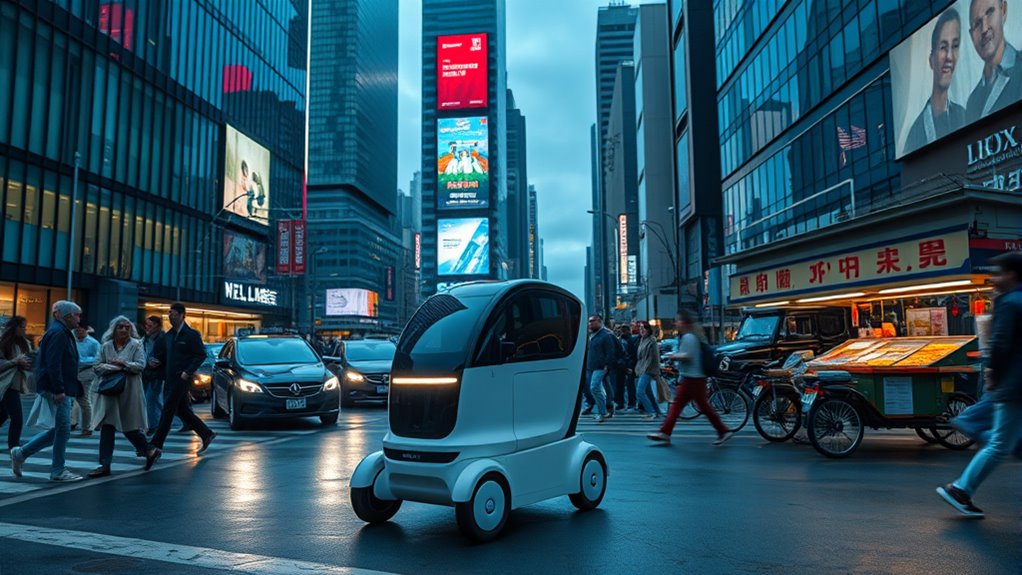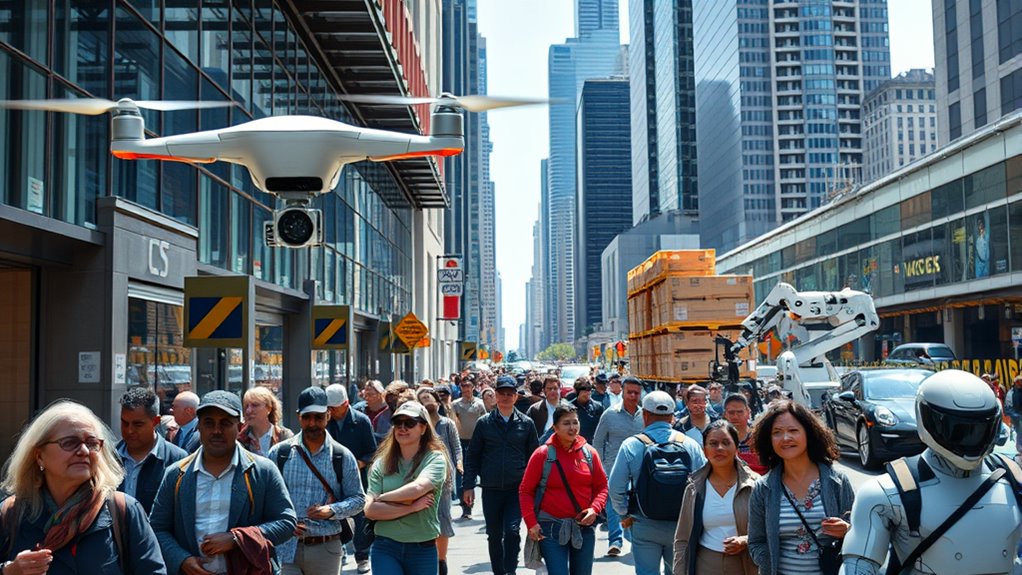Automation is transforming industries fast, but its benefits tend to favor the wealthy and resource-rich, widening inequality. Many low-skilled jobs face displacement, while high-income roles in tech and data benefit more from automation. Without policies and skills development, most workers may not share equally in the gains. If you want to understand how society can guarantee everyone benefits from automation’s promise, there’s more to explore below.
Key Takeaways
- Automation can increase productivity and reduce costs, but benefits often favor resource-rich organizations and high-income roles.
- Displacement risks mainly affect manual, low-skilled jobs, potentially widening economic inequality without targeted policies.
- Equitable benefits depend on investments in workforce retraining, digital literacy, and inclusive adoption strategies.
- Small and less affluent organizations face barriers like high costs and data infrastructure gaps, limiting their ability to benefit.
- Soft skills like creativity and emotional intelligence become vital for workers to remain relevant in an automated economy.
The Current Landscape of Business Automation

The current landscape of business automation is marked by rapid growth and widespread adoption driven by technological advancements. The global market is expected to surpass $45 billion by 2032, reflecting increased investments and interest. Digital channels are fueling demand; by 2025, 80% of B2B sales engagements will happen online, emphasizing automation’s role. Automation reduces errors by up to 70% and boosts productivity for 66% of knowledge workers, making everyday tasks more efficient. Many industries, especially finance, face issues with outdated systems, which automation can fix. AI integration is reshaping roles, with 74% of sales professionals impacted. Low-code and no-code solutions are making automation more accessible, and over 40% of U.S. work can now be automated or augmented with AI, driving operational efficiency. AI is comparable in impact to the steam engine of the 19th-century Industrial Revolution, highlighting its potential to transform entire sectors and workflows. Additionally, as organizations adopt these technologies, the importance of customized solutions tailored to specific business needs becomes increasingly evident. Incorporating user-friendly tools can further accelerate adoption and maximize benefits across diverse industries, especially as they address outdated systems that hinder operational efficiency. Moreover, integrating these tools with existing infrastructures can help organizations overcome technological barriers more effectively.
How Automation Is Reshaping Employment Opportunities

As automation and AI continue to advance, they are fundamentally transforming employment opportunities across industries. About 14% of workers have already experienced job displacement due to these technologies, with AI contributing to 5% of recent U.S. job losses. Sectors like tech saw their largest layoffs since 2001, and companies like British Telecom plan to cut thousands of jobs over the next few years, citing automation. Certain roles, such as medical transcriptionists and customer service reps, are expected to decline by around 5% by 2033, while others like financial advisors may see growth. Automation boosts productivity but also shifts skill demands, emphasizing tech literacy, creativity, and complex problem-solving. The increasing reliance on specialized hardware in arcade machines exemplifies how technological advancements can streamline operations and enhance user experiences. The projected economic impact of AI is estimated at $15.7 trillion by 2030. Additionally, the rapid evolution of workforce skills underscores the need for continuous learning and adaptation. As industries continue to adopt automation technologies, the demand for adaptable and tech-savvy workers will only grow, highlighting the importance of developing versatile skill sets. The rapid pace of technological change underscores the importance of ongoing upskilling and adaptability for the workforce. Developing a strong mindset of growth can help workers navigate these shifts more effectively. Overall, automation reshapes the job landscape, creating both challenges and opportunities for workers.
Sectors Most Vulnerable to Automation Disruption

You’ll notice that industries relying on routine, manual tasks face the highest risk of automation disruption. Jobs involving repetitive data entry, assembly line work, or basic customer service are increasingly replaced by AI and robots. As these sectors transform, workers in manual labor roles need to contemplate how automation might reshape their futures. Economic indicators like yield curve inversions are accelerating AI adoption, signaling a potential rapid shift in employment landscapes. Additionally, the use of sound design techniques in trailer music can influence audience perception and engagement, highlighting how automation in creative fields is also evolving. The integration of Glycolic acid benefits into skincare routines exemplifies how automation can enhance product development and personalization in the beauty industry. Recognizing the role of automated manufacturing processes can help workers understand shifts in production and job opportunities, especially as these advanced systems become more prevalent in Honda Tuning applications like engine tuning and performance upgrades. Moreover, understanding PlayStation Support Hours and scheduling can help consumers navigate tech support disruptions caused by automation advancements.
High-Risk Industries
High-risk industries face significant disruption from automation, threatening many jobs and fundamentally changing operations. In transportation and warehousing, about 80% of companies aren’t ready for supply chain shifts driven by automation, risking jobs like truck drivers, delivery staff, and warehouse workers. Automated vehicles and drones are already replacing human roles, potentially displacing millions. Manufacturing and production jobs, especially those involving repetitive tasks, have up to a 100% automation potential, impacting machine operators and food production workers. In administrative roles, over 90% of tasks can be automated, threatening clerical jobs like mail and office machine operators. Even in agriculture, some roles like logging equipment operation could become fully automated. These sectors face rapid changes, risking job loss for workers unprepared for technological shifts. 51% of job tasks nationwide are at risk of automation, which underscores the urgency for workforce adaptation strategies in these vulnerable sectors. Moreover, the pace of technological advancement emphasizes the importance of understanding automation potential and planning for a changing employment landscape. Recognizing the impact of advanced technology on job security can help policymakers and organizations develop effective mitigation measures. Additionally, integrating self-sufficiency skills like food preservation and alternative energy sources can help workers adapt to economic shifts caused by automation.
Manual Labor Vulnerability
Manual labor sectors are among the most vulnerable to automation because their tasks are often repetitive and physically routine. About 30% of all workers face exposure to advanced automation, mainly in manufacturing, where up to 20 million jobs could be lost globally in the next decade. For example, one robot can replace 1.6 workers. Sectors like transport, maintenance, and construction are also at high risk, especially those with repetitive physical tasks. The table below highlights key vulnerable sectors:
| Sector | Tasks Commonly Automated | Displacement Risk |
|---|---|---|
| Manufacturing | Repetitive assembly | Very high |
| Transportation | Routine driving | High |
| Construction | Physical, repetitive | Moderate to high |
Manual jobs requiring face-to-face skills are less at risk, but limited education and retraining worsen displacement challenges. Additionally, the holistic health benefits of diverse practices like yoga emphasize the importance of adaptable skills and well-being in times of change. Furthermore, the integration of robotics and automation technologies continues to accelerate, making it crucial for workers to develop versatile skills to stay relevant.
Economic Benefits Versus Social Challenges of Automation

Automation boosts economic growth but can also widen the wealth gap and displace workers. You might wonder if the benefits reach everyone or mostly favor the wealthy and business owners. As these changes accelerate, it’s essential to take into account how society can balance progress with social fairness. Studies show that up to 80% of transactional workflows in finance are automatable, which could disproportionately benefit large corporations over small businesses or individual workers.
Wealth Gap Expansion
While automation offers significant economic advantages like increased productivity and cost savings, it also risks widening the wealth gap. High-income workers in knowledge-based roles tend to benefit most from AI-driven productivity boosts, increasing their earnings and economic power. Meanwhile, those in lower-skilled, manual, or service jobs often see fewer benefits or are left behind altogether. This sector polarization can deepen existing inequalities, both within countries and globally. Smaller firms face barriers to adopting automation due to high costs and technical challenges, limiting access to its gains. As a result, resources and opportunities concentrate among the already resource-rich, widening the divide between the wealthy and everyone else. Research indicates that resources and opportunities tend to concentrate among the already resource-rich, widening the divide between the wealthy and everyone else. Without deliberate policies, automation’s benefits may largely accrue to the top, exacerbating societal inequality.
Workforce Displacement Risks
As automation continues to advance, a growing number of jobs are at risk of displacement, posing significant social challenges alongside its economic benefits. Over 19 million US jobs face high or very high displacement risks, especially in blue-collar, administrative, and service roles. By 2030, 14% of the global workforce may need to change careers due to AI, with robots projected to displace 5 million jobs. Many workers, particularly young adults, worry about job obsolescence, and 30% fear losing their jobs to AI by 2025. While automation drives efficiencies and creates new opportunities in AI development, it also emphasizes the need for retraining and workforce development. Proactive investments in education and human-AI collaboration are essential to minimizing displacement and ensuring economic benefits are shared broadly.
Barriers Hindering Equitable Automation Adoption

Despite the potential of automation to drive growth and efficiency across industries, numerous barriers prevent its equitable adoption. Many companies worry about poor data quality, with 56% citing it as a major concern, and 80% lack the necessary data infrastructure for AI. Without clean, structured data and extensive knowledge bases, AI cannot operate effectively. Organizational hurdles like employee resistance, insufficient buy-in, and a shortage of skilled AI talent also slow progress. Regulatory challenges, including restrictive laws and trust issues, further complicate adoption. Technical barriers, such as integrating AI into existing systems and managing complex processes, add to the difficulty. Additionally, high implementation costs and resource disparities limit access, making it harder for smaller or less affluent organizations to benefit equally from automation.
The Evolving Skills Needed in an Automated Workforce

Automation is transforming workplaces, requiring you to develop new skills to keep pace with technological advances. You need to understand AI fundamentals, work fluently with data, and grasp machine learning concepts. Technical agility is essential, enabling you to adapt swiftly to emerging tools and platforms. Additionally, continuous learning helps you stay relevant, whether through cross-department projects or change management training. Developing adaptability involves embracing feedback, exploring new digital tools, and fostering a culture of experimentation. Creativity remains critical, with opportunities to leverage AI for innovative solutions and collaborative brainstorming. Equally important are soft skills like emotional intelligence, empathy, and cross-cultural communication, which AI cannot replicate. These skills ensure you remain valuable in an automated workforce that demands both technical proficiency and human-centered capabilities.
Ensuring Inclusive Growth in the Age of Automation

Ensuring inclusive growth in the age of automation requires deliberate efforts to expand access to new technologies and skills. You need to bridge gaps that prevent smaller or less-resourced companies from benefiting equally, avoiding widening inequality. Investing in accessible automation platforms and training is vital. Consider this table illustrating the barriers and opportunities:
| Barrier | Impact | Solution |
|---|---|---|
| High implementation costs | Limits small business access | Subsidies, shared platforms |
| Uneven technology adoption | Creates economic divides | Promote widespread infrastructure |
| Lack of skills | Hinders workforce inclusion | Reskill programs, education |
| Resistance to change | Slows adoption | Awareness campaigns |
| Infrastructure gaps | Restricts market growth | Public investment |
Frequently Asked Questions
How Will Automation Impact Income Inequality Across Different Socioeconomic Groups?
You might wonder how automation impacts income inequality across different socioeconomic groups. Automation tends to widen gaps by displacing low-skilled workers, causing wage stagnation for them, while high-skilled and capital owners benefit. This increase in disparities means lower-income groups face higher risks of job loss, while wealth concentrates among the wealthy. If these trends continue, inequality could deepen, making it harder for disadvantaged groups to catch up economically.
What Policies Are Needed to Ensure Automation Benefits All Workers Equally?
You’re wondering what policies can guarantee automation benefits everyone equally. To achieve this, you need targeted solutions like retraining programs for displaced workers, fair wages, and social safety nets. You should also support digital literacy, make certain access to technology, and promote ethical AI practices. By implementing these measures, you create a more inclusive future where automation serves all, not just the privileged few.
Will Automation Lead to Universal Basic Income or Other Social Safety Nets?
Automation is likely to prompt the adoption of social safety nets like Universal Basic Income, but it won’t automatically guarantee their implementation. You’ll need active policies, strong political will, and public support to establish these programs. As automation displaces jobs, you should advocate for measures that support workers, including UBI and retraining initiatives, to make certain that technological progress benefits everyone, not just the wealthy or a select few.
How Can Small Businesses Afford Automation Without Widening Economic Disparities?
They say, “A rising tide lifts all boats,” but automation can widen gaps if you’re not careful. To avoid this, you can leverage affordable solutions like cloud-based tools, open-source software, and automation-as-a-service. Collaborate with others, start small, and invest in training. These steps help small businesses adopt automation cost-effectively, ensuring you stay competitive without amplifying economic disparities. Embrace gradual change and inclusive policies for a more equitable future.
What Role Do Governments Play in Preventing Automation From Favoring the Wealthy?
Governments play a key role in preventing automation from favoring the wealthy by implementing fair tax policies that target capital gains and automation profits. They can also boost social safety nets, retraining programs, and education to support low-skilled workers. By investing in technologies that complement human labor and promoting redistribution measures, you guarantee automation benefits everyone, not just the rich, fostering a more equitable economy.
Conclusion
Automation has the potential to boost productivity and economic growth, but it also risks widening inequality. Did you know that 85% of jobs in 2030 haven’t even been invented yet? To benefit everyone, you need to promote inclusive policies and lifelong learning. By remaining adaptable and pushing for fair access, you can help ensure automation creates opportunities for all, not just the wealthy. The future depends on how we choose to shape it.









